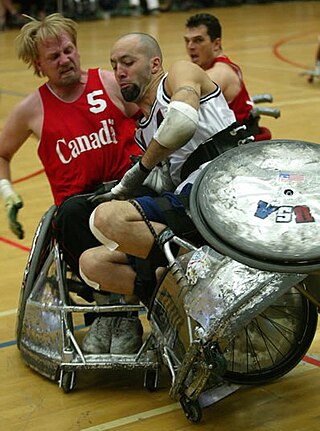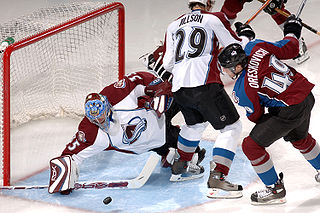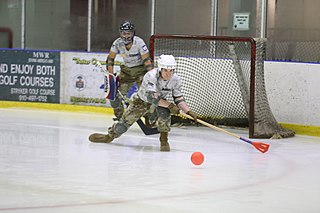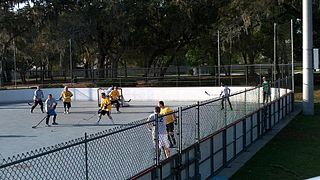
Bandy is a winter sport and ball sport played by two teams wearing ice skates on a large ice surface while using sticks to direct a ball into the opposing team's goal.

Field hockey is a team sport structured in standard hockey format, in which each team plays with 11 players in total, made up of 10 field players and a goalkeeper. Teams must move a hockey ball around a pitch by hitting it with a hockey stick towards the rival team's shooting circle and then into the goal. The match is won by the team that scores the most goals. Matches are played on grass, watered turf, artificial turf, or indoor boarded surface.

Floorball is a type of floor hockey with five players and a goalkeeper in each team. It is played indoors with 96–115.5 cm-long (37.8–45.5 in) sticks and a 70–72 mm-diameter (2.76–2.83 in) plastic ball with holes. Matches are played in three twenty-minute periods. The sport of bandy also played a role in the game's development.

Hockey is a term used to denote a family of various types of both summer and winter team sports which originated on either an outdoor field, sheet of ice, or dry floor such as in a gymnasium. While these sports vary in specific rules, numbers of players, apparel, and playing surface, they share broad characteristics of two opposing teams using a stick to propel a ball or disk into a goal.

Ice hockey is a team sport played on ice skates, usually on an ice skating rink with lines and markings specific to the sport. It belongs to a family of sports called hockey. In ice hockey, two opposing teams use ice hockey sticks to control, advance, and shoot a closed, vulcanized, rubber disc called a "puck" into the other team's goal. Each goal is worth one point. The team which scores the most goals is declared the winner. In a formal game, each team has six skaters on the ice at a time, barring any penalties, one of whom is the goaltender. Ice hockey is a full contact sport, and is considered to be one of the more physically demanding team sports.
Roller hockey is a form of hockey played on a dry surface using wheeled skates. It can be played with traditional roller skates or with inline skates and use either a ball or puck. Combined, roller hockey is played in nearly 60 countries worldwide.

In many team sports that involve scoring goals, the goalkeeper is a designated player charged with directly preventing the opposing team from scoring by blocking or intercepting opposing shots on goal. Such positions exist in bandy, rink bandy, camogie, association football, Gaelic football, international rules football, floorball, handball, hurling, field hockey, ice hockey, roller hockey, lacrosse, ringette, rinkball, water polo, and shinty, as well as in other sports.
"Power play" is a sporting term used to describe a period of play where one team has a numerical advantage in players, usually due to a rule violation by the opposing team.

Box lacrosse, also known as boxla, box, or indoor lacrosse, is an indoor version of lacrosse played mostly in North America. The game originated in the 1930s in Canada, where it is more popular than field lacrosse. Lacrosse is Canada's official national summer sport. Box lacrosse is played between two teams of five players and one goalie each, and is traditionally played on an ice hockey rink once the ice has been removed or covered. The playing area is called a box, in contrast to the open playing field of field lacrosse. The object of the game is to use a lacrosse stick to catch, carry, and pass the ball in an effort to score by shooting a solid rubber lacrosse ball into the opponent's goal. The highest level of box lacrosse is the National Lacrosse League.

Wheelchair rugby is a team sport for athletes with a disability. It is practiced in over twenty-five countries around the world and is a summer Paralympic sport.

In ice hockey, the goaltender is the player responsible for preventing the hockey puck from entering their team's net, thus preventing the opposing team from scoring. The goaltender mostly plays in or near the area in front of the net called the goal crease. Goaltenders tend to stay at or beyond the top of the crease to cut down on the angle of shots. In the modern age of goaltending there are two common styles, butterfly and hybrid. Because of the power of shots, the goaltender wears special equipment to protect the body from direct impact.

A penalty in ice hockey is a punishment for an infringement of the rules. Most penalties are enforced by sending the offending player to a penalty box for a set number of minutes. During the penalty the player may not participate in play. Penalties are called and enforced by the referee, or in some cases, the linesman. The offending team may not replace the player on the ice, leaving them short-handed as opposed to full strength. When the opposing team is said to be on a power play, they will have one more player on the ice than the short-handed team. The short-handed team is said to be "on the penalty kill" until the penalty expires and the penalized player returns to play. While standards vary somewhat between leagues, most leagues recognize several common varieties of penalties, as well as common infractions.

Broomball is a both a recreational and organized competitive winter team sport played on ice or snow and is played either indoors or outdoors, depending on climate and location. It is a ball sport and is most popularly played in Canada and the United States.

Street hockey is a collection of team sport variants played outdoors either on foot or with wheeled skates, using a either a ball or puck designed for play on flat, dry surfaces. The object of every game is to score more goals than the opposing team by shooting the ball or puck into the opposing team's net. All games are derivatives of either the sport of ice hockey, floor hockey, bandy, and/or field hockey.

Floor hockey is a broad term for several indoor floor game codes which involve two teams using a stick and type of ball or disk. Disks are either open or closed but both designs are usually referred to as "pucks". These games are played either on foot or with wheeled skates. Variants typically reflect the style of ice hockey, field hockey, bandy or some other combination of sport. Games are commonly known by various names including cosom hockey, ball hockey, floorball, or simply floor hockey.

Roller in-line hockey, or inline hockey is a variant of hockey played on a hard, smooth surface, with players using inline skates to move and ice hockey sticks to shoot a hard, plastic puck into their opponent's goal to score points. The sport is a very fast-paced and free-flowing game and is considered a contact sport, but body checking is prohibited. There are five players including the goalkeeper from each team on the rink at a time, while teams normally consist of 16 players. There are professional leagues, one of which is the National Roller Hockey League (NRHL). While it is not a contact sport, there are exceptions, i.e. the NRHL involves fighting.

Sledge hockey, also known as Sled hockey in American English, and Para ice hockey in international competition, is an adaptation of ice hockey for players who have a physical disability. The sport was invented in the early 1960s at a rehabilitation centre in Stockholm, Sweden, and played under similar rules to standard ice hockey. Players are seated on sleds and use special hockey sticks with metal "teeth" on the tips of their handles to navigate the ice. Playing venues use an ice hockey rink.

The National Hockey League rules are the rules governing the play of the National Hockey League (NHL), a professional ice hockey organization. Infractions of the rules, such as offside and icing, lead to a stoppage of play and subsequent to the offending teams. The league also determines the specifications for playing equipment used in its games.
This is a list of common terms used in the sport of ice hockey along with the definitions of these terms.

Ball hockey is a team sport and an off-ice variant of the sport of ice hockey. The sport is also a variant of one of several floor hockey game codes but more specifically a variant of street hockey.
















